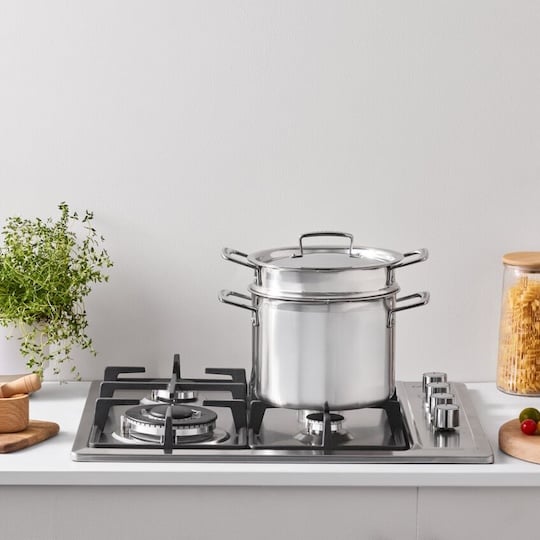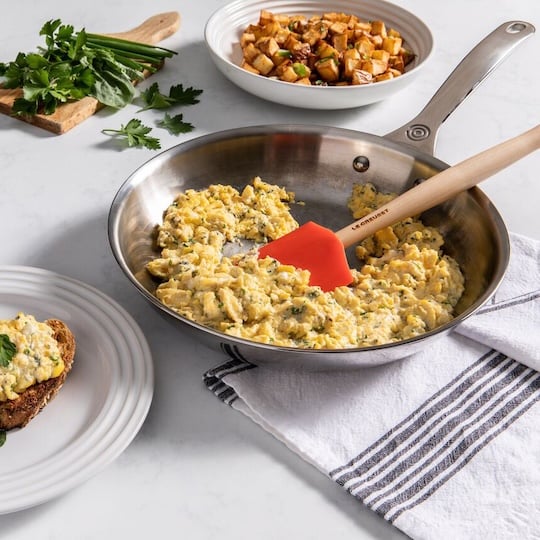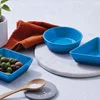Since 1925, Le Creuset has been the first in colorful cookware, the finest in quality and design, and the favorite for generations, sharing in the meals, memories and traditions made by food lovers around the world. Every product is expertly crafted with only the highest quality raw materials and optimized for beauty, durability and superior results.
All our materials are versatile and essential components of a well-stocked kitchen. Le Creuset enameled cast iron has been the visionary color and quality benchmark for almost a century, beloved for its perfected design and exceptional heat retention that produces superior results, from stove to oven to table. While enameled cast iron is the leader in heat retention, our tri-ply stainless steel assortment is lighter and more heat responsive, and is more durable than anodized aluminum. Le Creuset Toughened Non-stick PRO and Essential Non-stick Ceramic cookware easily releases food and quickly wipes clean, and is more heat responsive than both enameled cast iron and tri-ply stainless steel.
Stainless steel – ideal for everything from searing meats to sautéing vegetables and crafting irresistible and rich savory pan sauces – is loved by professionals and home cooks alike for many reasons. Versatile, durable and easy to clean, stainless steel cookware can withstand the test of time. However, the idea of cooking with stainless steel can often be intimidating.
From heating the pans properly to choosing the right cooking oil, some simple techniques can transform your culinary experience. Here’s how to get the most from your Le Creuset stainless steel cookware.
Shop Le Creuset Stainless SteelTips and Tricks for Cooking with Stainless Steel

Getting Started
Start by removing all packaging and labels. Wash your new cookware in warm, soapy water and rinse and dry thoroughly. Your stainless steel is now ready to be used and does not require any further preparation.

Proper Preheating is Key
Le Creuset stainless steel cookware provides excellent heat distribution, and one of the most common reasons for food sticking is not properly preheating. Preheat your empty pan on medium heat for just a few minutes until the pan is hot. A preheated pan will also ensure your food cooks evenly.
You can use the water droplet test to ensure your pan is properly preheated: add a few drops of water to the hot pan; if they form small beads that dance along the surface, the pan is hot enough and ready to use.

Prep Your Ingredients
Bringing your ingredients to room temperature prior to cooking with stainless steel is also key, as cold food lowers the pan’s surface temperature, which in turn can lead to sticking. Excess moisture can also cause sticking, so it’s recommended to pat food completely dry before adding to the pan.

Add Fat
To prevent food sticking in your stainless steel pan, it’s important to use some kind of oil, butter or other kind of fat. After your pan has preheated for 2-3 minutes, add your fat source and continue heating on low to medium heat until the oil is shimmering, but not smoking.
Recommended fat sources:
- Butter: for cooking eggs on low heat
- Olive oil: for sauteing vegetables or cooking delicate fish on moderate heat
- Grapeseed or vegetable oil: for searing proteins on high heat
While counter intuitive, we do not recommend using a non-stick aerosol spray on your Le Creuset stainless steel cookware.

Be Patient
While sometimes the hardest to master, patience is key when cooking with stainless steel cookware!
Allow your pan to heat properly before adding oil or food to ensure your pan heats evenly and minimize sticking. And while it may be tempting, avoid constantly stirring or flipping your food – if you move it too early, it will stick to the pan. When your food is ready to turn, it will start to release from the edges.

Other Tips and Tricks for Cooking with Le Creuset Stainless Steel
- Le Creuset stainless steel cookware is compatible with all cooktops and seamlessly transitions from stovetop to oven, safe up to 500°F. If placing the pan under a broiler, be sure there are at least 2 inches of space between the heat source and the top of the pan.
- If you have a glass-topped stovetop, be sure to lift the pan to move it instead of sliding it across the cooktop surface.
- A slow temperature transition ensures even heat distribution. When transitioning your stainless steel from stove to oven, warm your dish on the stovetop before transferring to a preheated oven.
- Deglazing the pan will make cleaning your stainless steel easier and will enhance the flavor of your dishes. Be sure to take advantage of the fond – the flavorful browned bits that form on the bottom of the pan during cooking – by deglazing it with wine, broth or another liquid.









